How to clean a coffee maker might not be the first thing to come to mind when you use your machine daily. There are many good reasons to regularly clean your coffee maker, one is hygiene.
The warm and mosit environment inside the water reservoir is a great breeding ground for mold and bacteria. Another reason is flavor, if your morning coffee starts to taste bitter or funky is because it’s time to give your coffee machine some cleaning.
A simple cleaning done regularly will help maintain freshness, remove hard water spots from the glass or plastic carafe, and prevent coffee staining. With regular cleaning you make sure to remove mineral deposit buildup and clean out the coffee oils and water minerals that get left behind.
The great news is that it’s very easy to do and you most probably already have everything you need to clean your coffee maker at home. So let’s get started!
How to Clean a Coffee Maker – Step by Step
First off we will start by making sure there is no filter in the coffee basket of the coffee machine.
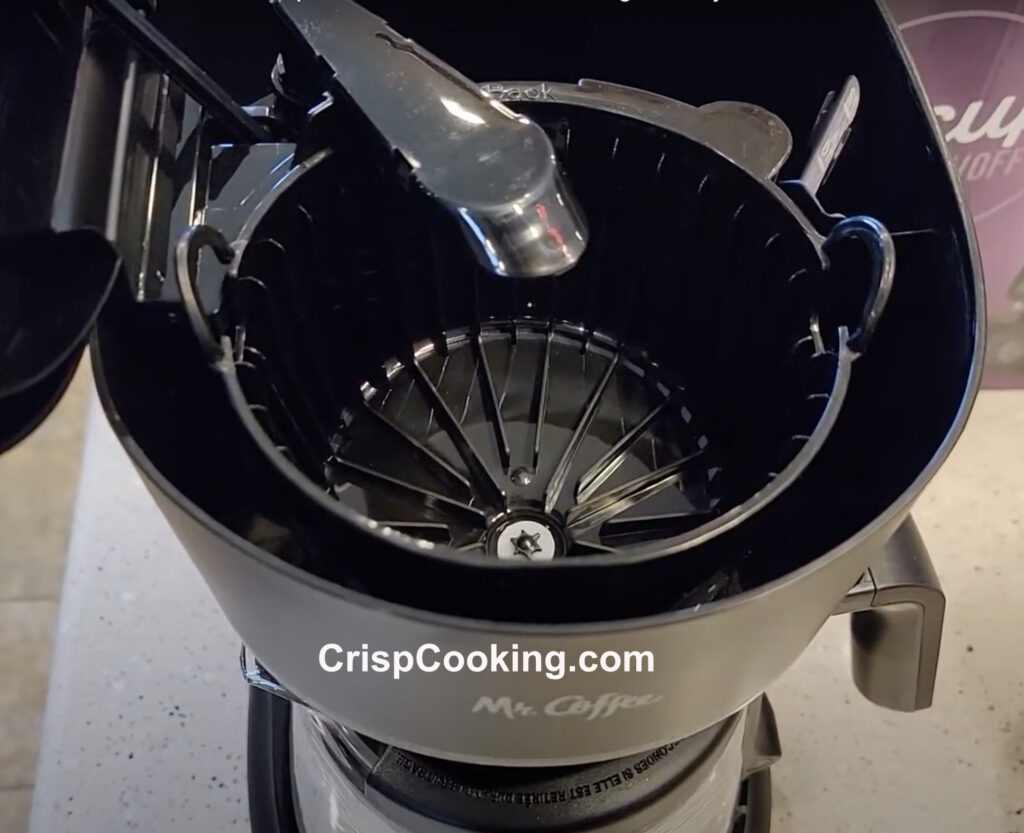
You will pour six cups of white vinegar where the water normally goes, where I am pointing in the following picture.
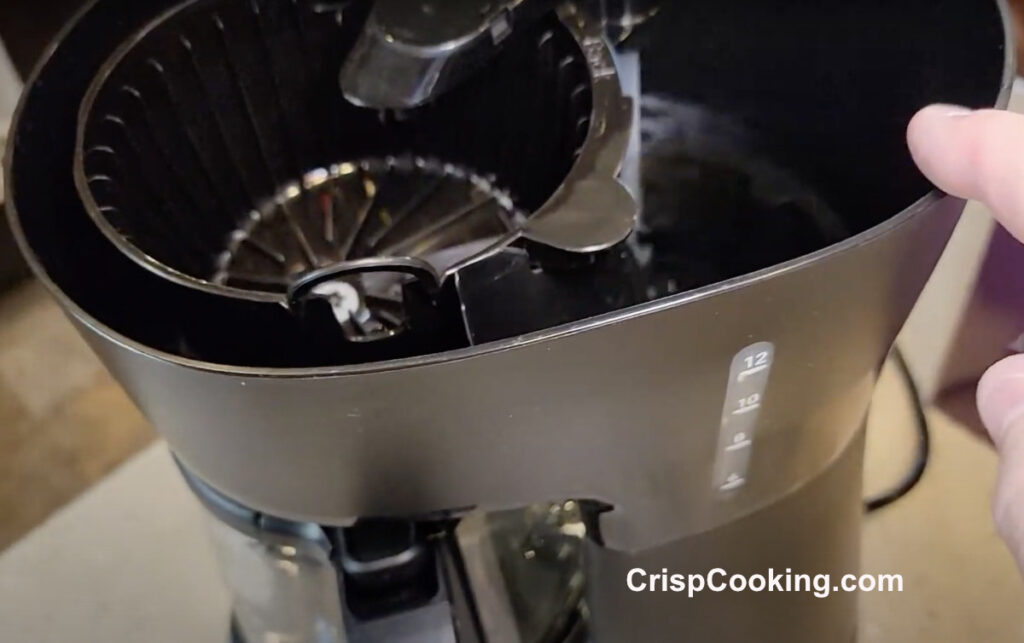
You make sure there are 6 cups by checking on the side and making sure you reach the 6 cup line like in the following picture.
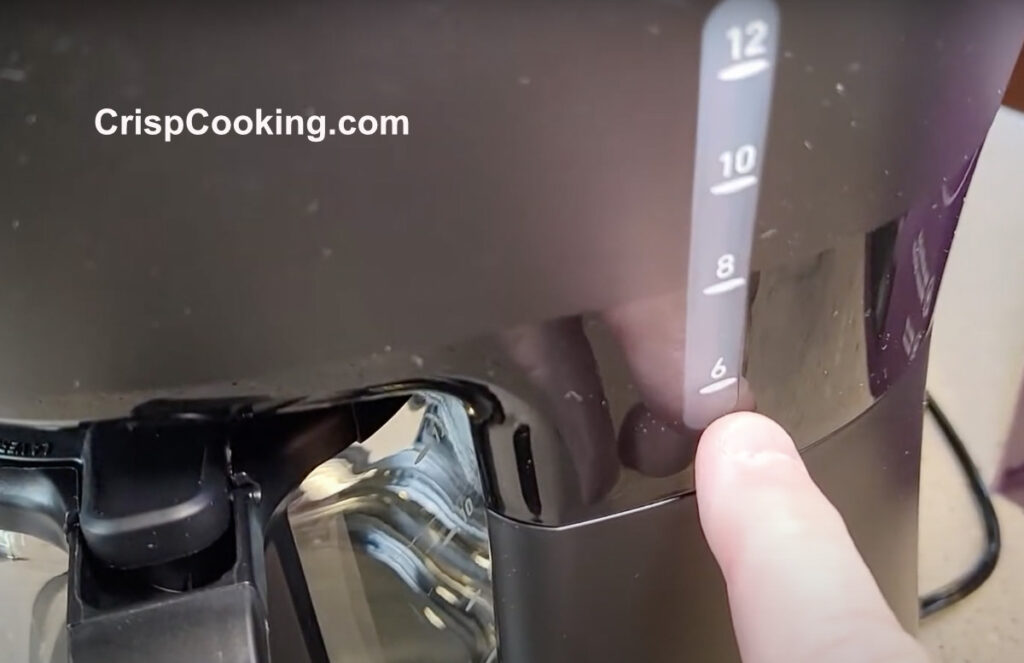
Now make sure the coffee basket of your machine is well placed and close the lid.
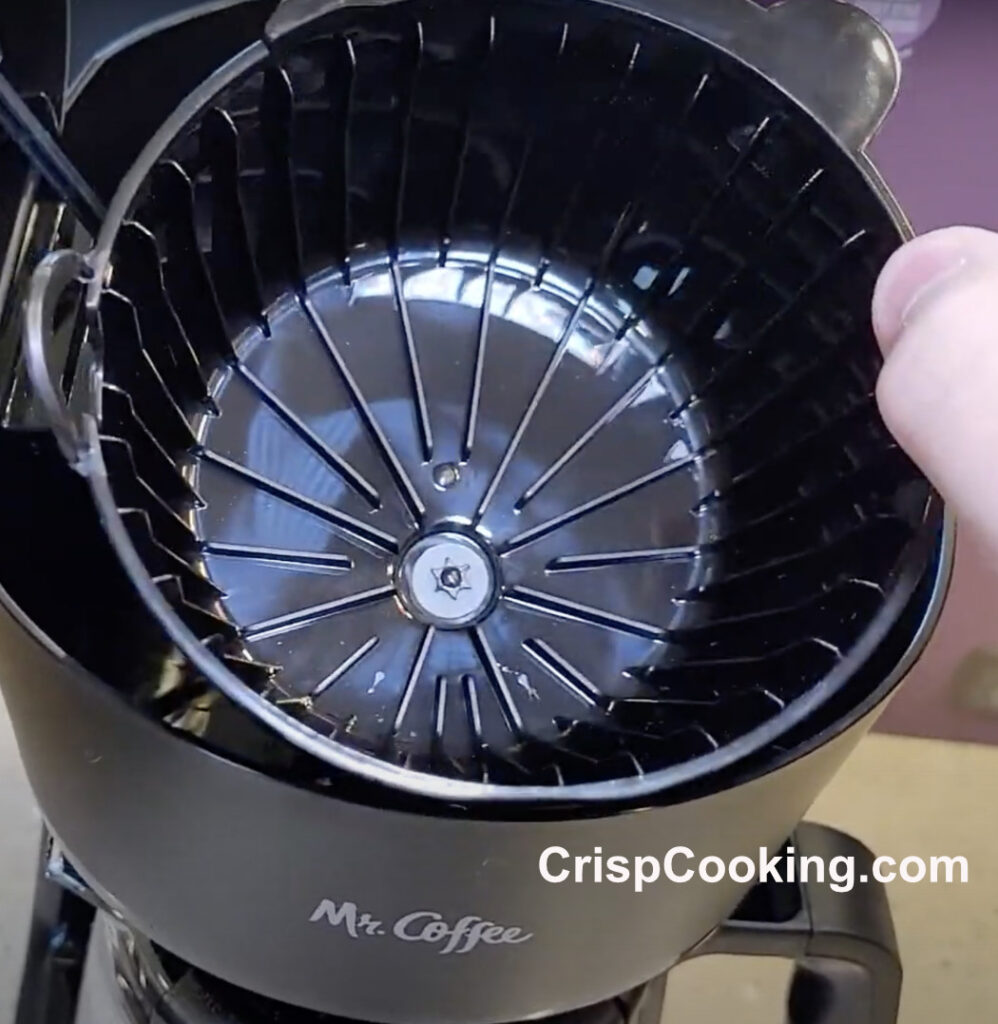
Place the glass coffee pot in its place. Make sure the coffee pot is clean with no coffee stains. If you need to clean it you can check our guide on how to clean a glass coffee pot to leave it like new again.
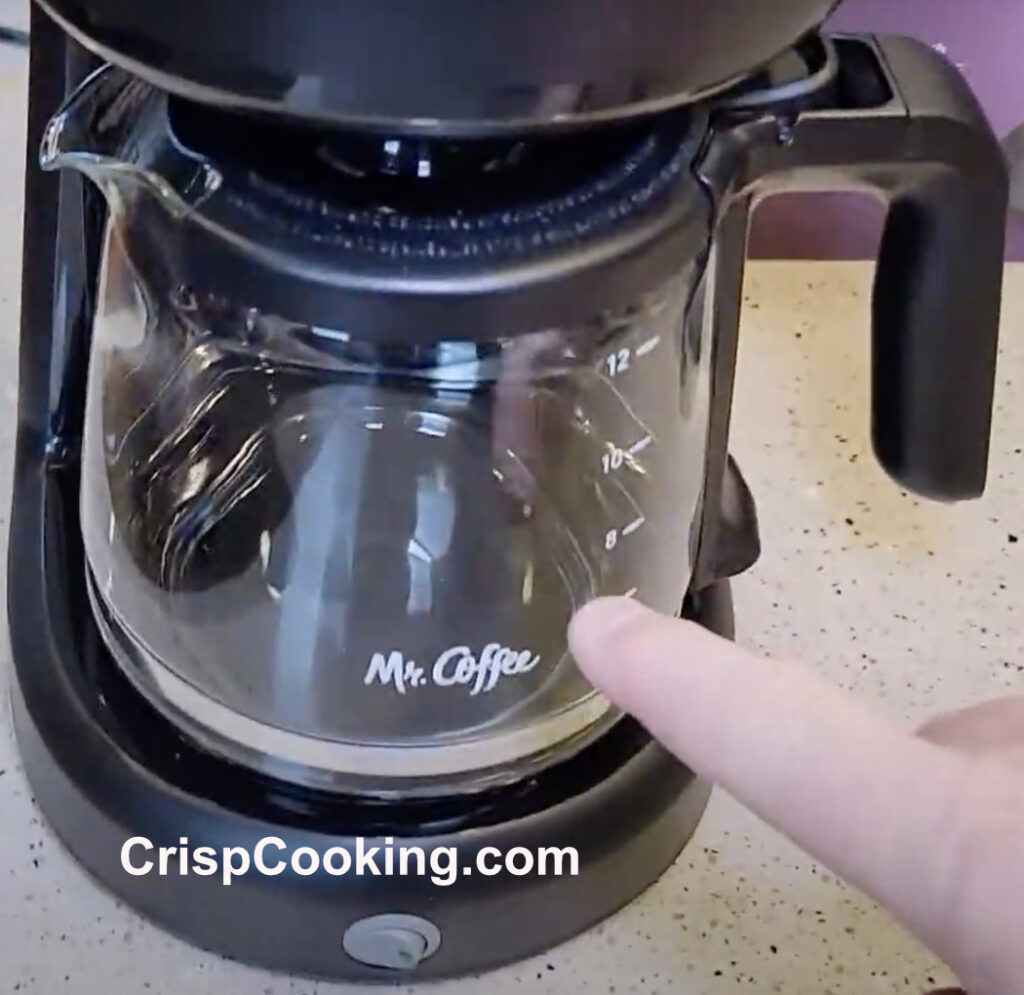
Now that you got your clean coffee pot well place you go ahead and push the start button on your coffee maker.

The white vinegar will start brewing. It will take about 6 minute to completely brew the 6 cups of white vinegar.
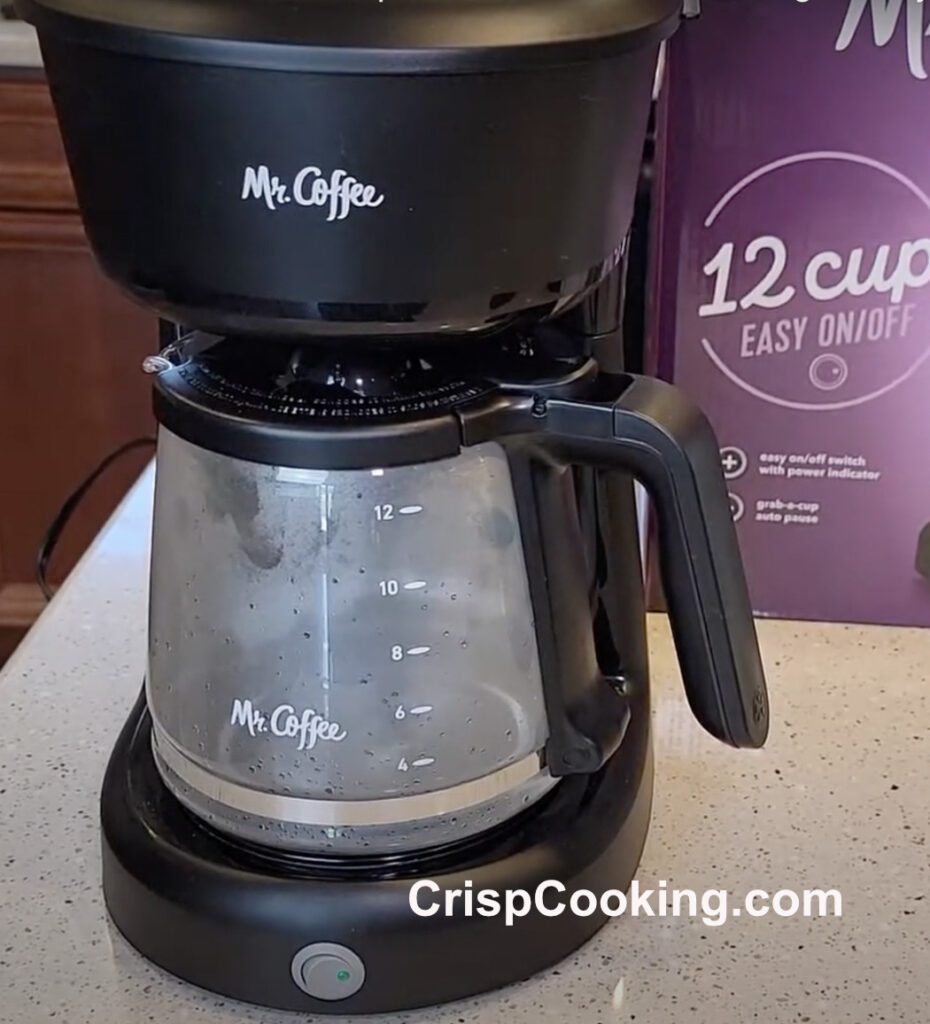
You can open the lid like in the next picture while it is brewing and see how hte white vinegar falls into the basket.

The machine is done when it reaches the 6 cup line in the glass coffee pot like in the following picture.
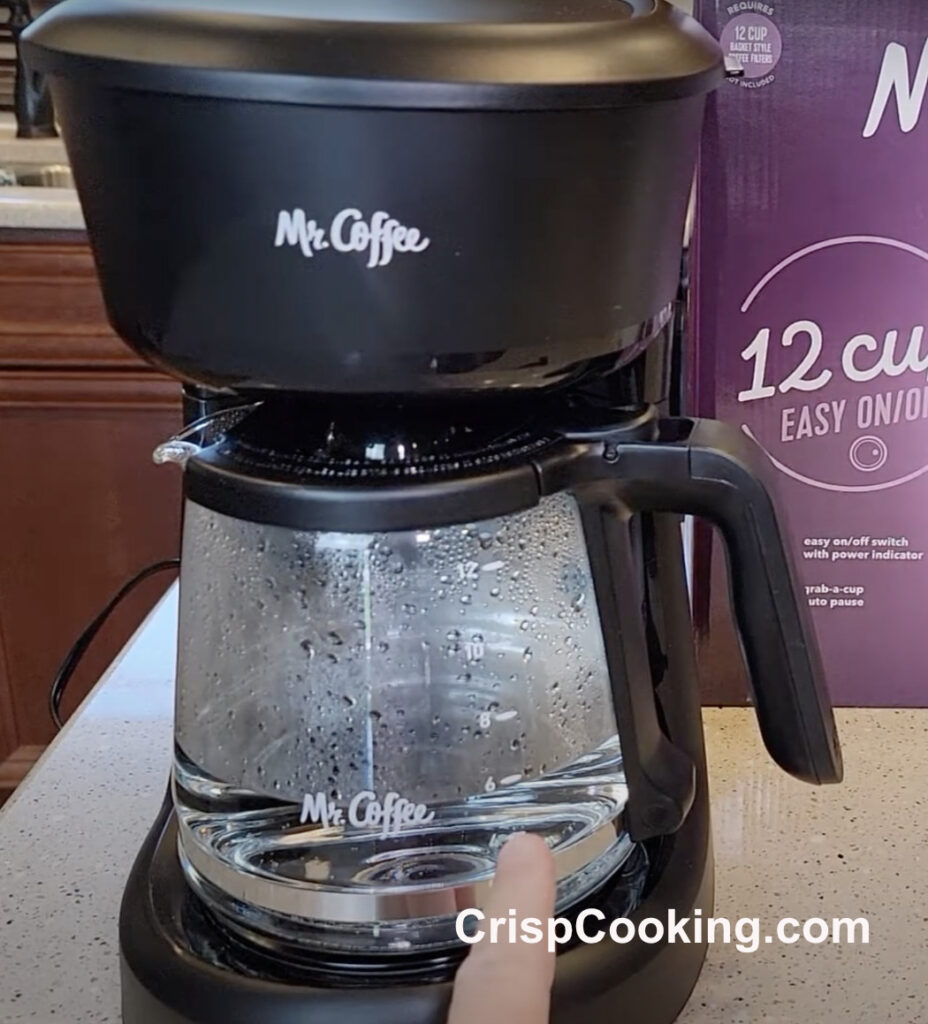
When it reaches the 6 cup line in the coffee pot you go ahead and push the off button to turn it off.

You remove the glass coffee pot and get rid of the white vinegar on your kitchen sink. Clean the coffee pot thoroughly with water and soap to completely remove the white vinegar.
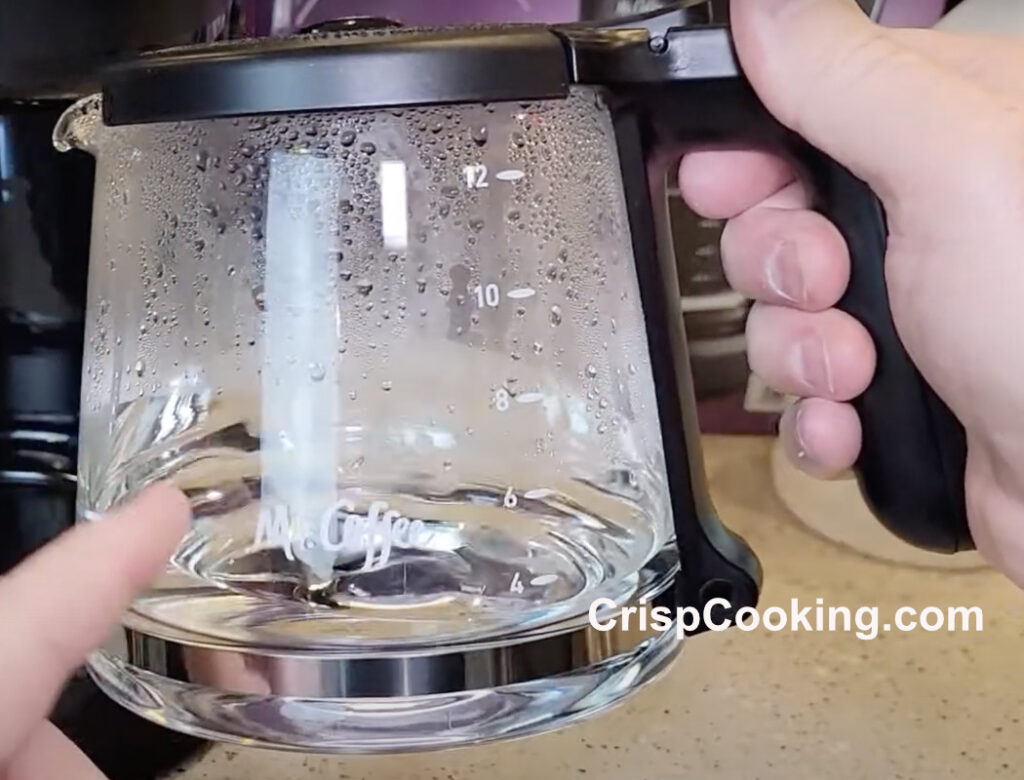
You do the same with the coffee basket, thoroughly clean it with water and soap to remove any white vinegar left.

Go ahead and fill the glass coffee pot with fresh water to the 12 cup line like in the following picture.
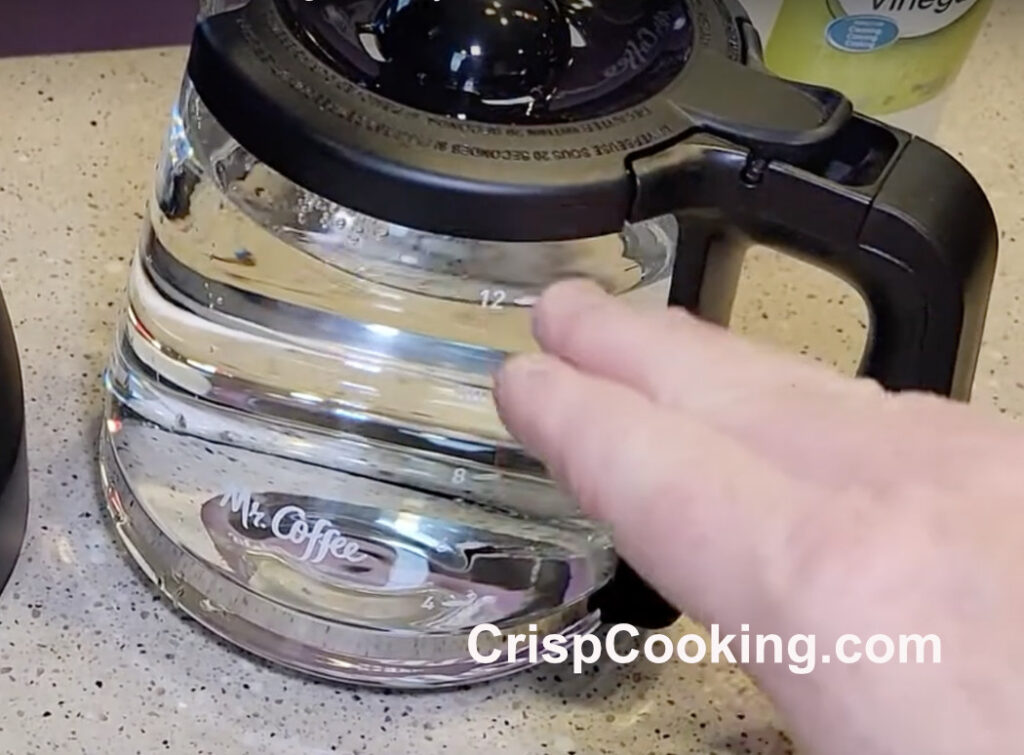
Pour the 12 cups of fresh water in the coffee maker like in the following picture.
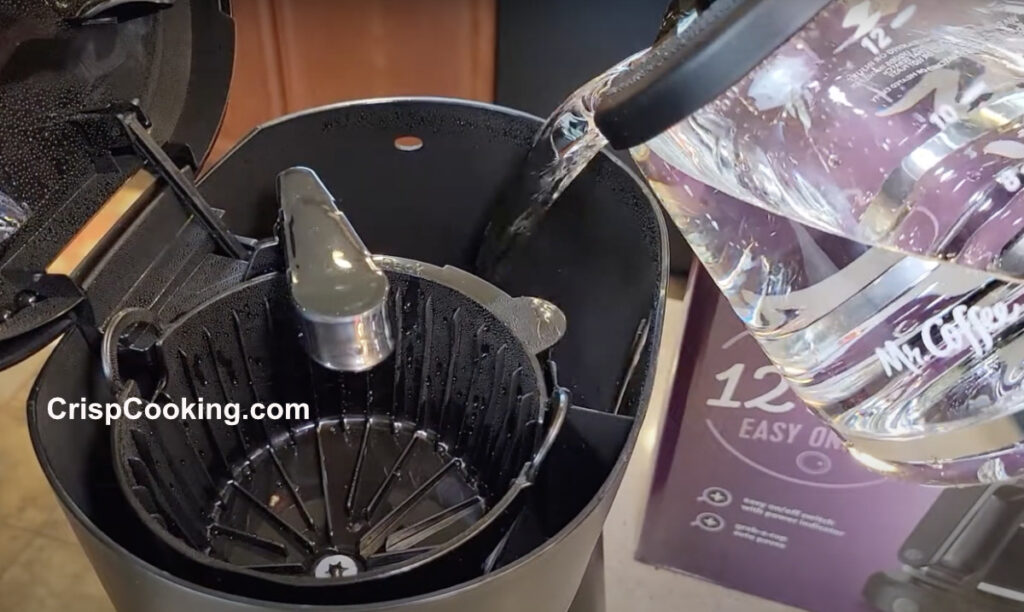
Once done, check the side of the coffee machine to confirm it is at the 12 cup line. Use the following image as reference.
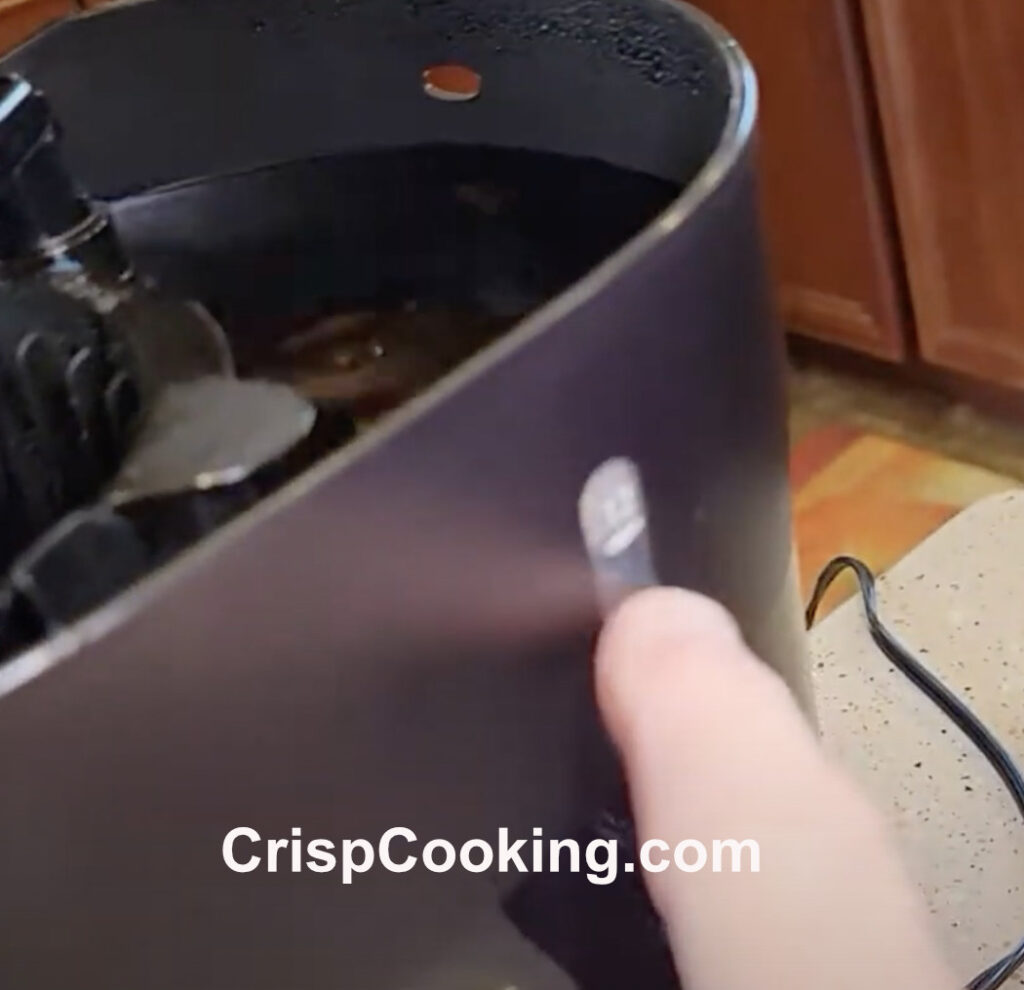
You can go ahead and push the start button to brew the water through the coffee maker system.
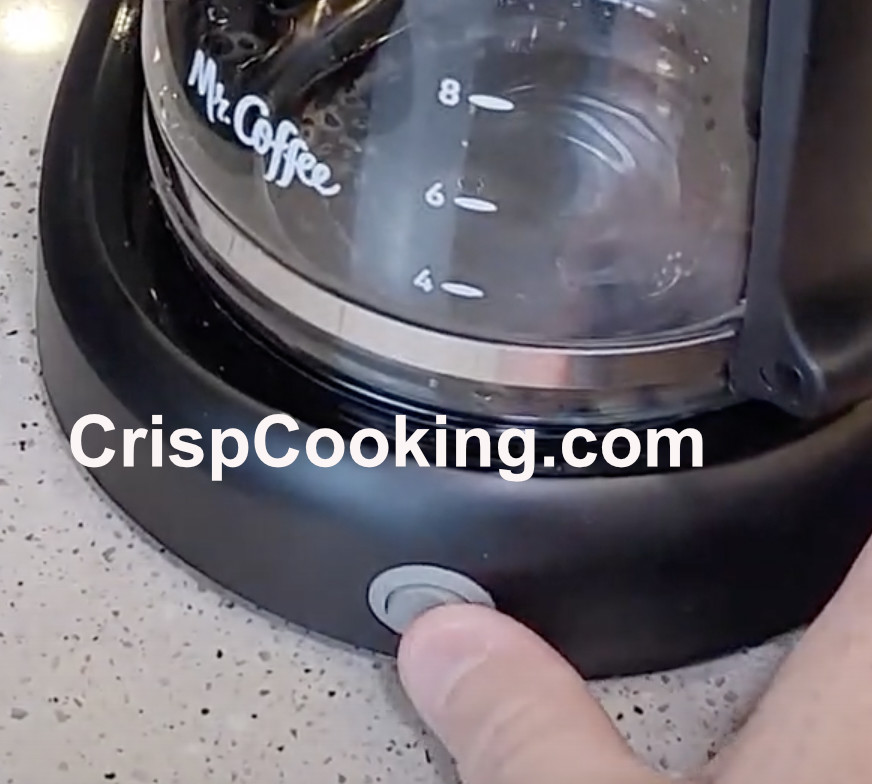
The reason to brew fresh water is to remove white vinegar from the pipes and all the system of the coffee machine. It will take around 3 to 4 rounds to completely get rid of that vinegar and the vinegar taste. So you will have to complete this step, brew 12 cups of fresh water, 3 to 4 times.
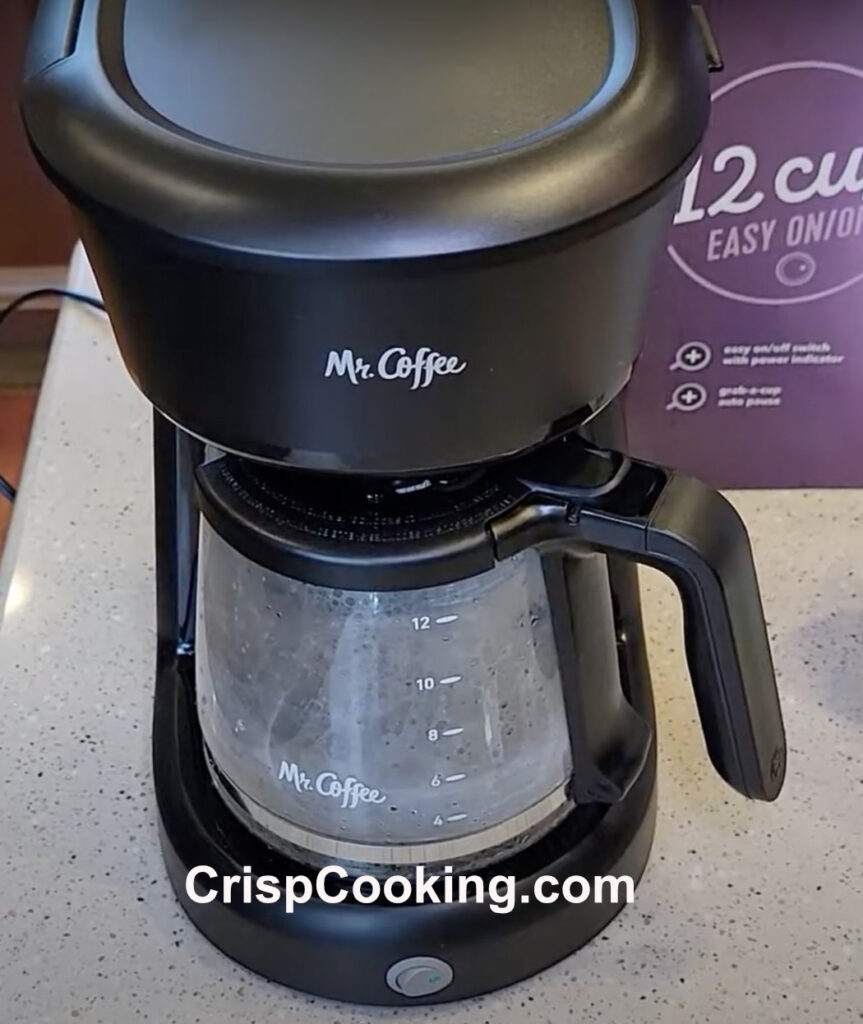
Algae in Coffee Maker Water Reservoir
If you notice algae growing in your coffee maker’s water reservoir, it is important to take immediate action to clean and sanitize the machine. Here are some steps you can follow:
- Unplug the coffee maker: Before you start cleaning, make sure to unplug the coffee maker from the power source to avoid any potential electrical hazards.
- Empty the water reservoir: Remove any remaining water from the reservoir and dispose of it.
- Clean the reservoir: Mix a solution of equal parts water and vinegar and pour it into the reservoir. Let it sit for about 30 minutes to an hour, depending on how severe the algae growth is.
- Scrub the reservoir: Use a soft-bristled brush or sponge to scrub the inside of the reservoir, paying special attention to any areas where algae is growing. Rinse thoroughly with clean water.
- Sanitize the reservoir: Mix a solution of 1 teaspoon of bleach with 1 gallon of water. Pour the solution into the reservoir and let it sit for about 15-20 minutes. Rinse the reservoir thoroughly with clean water.
- Run a brew cycle: Once the reservoir is cleaned and sanitized, run a brew cycle with clean water only to flush out any remaining traces of vinegar or bleach.
- Repeat if necessary: If the algae growth was severe or if there is still visible residue in the reservoir, you may need to repeat the cleaning and sanitizing process.
- Maintenance: To prevent future algae growth, make sure to empty and clean the water reservoir regularly, and refill it with fresh water each time you use the coffee maker. If you are still having issues with algae growth, you may need to use a specialized coffee maker cleaning solution or consult with the manufacturer for further assistance.
Why is My Coffee Maker Making Watery Coffee
There are several reasons why your coffee maker may be producing watery coffee. Here are a few possible causes:
- Incorrect coffee-to-water ratio: If you are not using enough coffee grounds or using too much water, the resulting coffee may be weak and watery. Try adjusting the ratio of coffee to water and see if this improves the strength of your coffee.
- Grind size: The grind size of your coffee can also affect the strength of the brew. If the coffee grounds are too coarse, the water may flow through too quickly, resulting in a weak coffee. If the grounds are too fine, the water may not be able to flow through, resulting in a bitter or over-extracted coffee. Try adjusting the grind size to see if this improves the flavor of your coffee.
- Water temperature: If the water temperature is too low, the coffee may not extract properly, resulting in a weak coffee. Make sure the water is heated to the proper temperature, which is typically between 195-205 degrees Fahrenheit (90-96 °C) for optimal coffee extraction.
- Brewing time: If the coffee is not brewing for long enough, the resulting coffee may be weak and watery. Try increasing the brewing time to see if this improves the flavor of your coffee.
- Clogged filter: A clogged filter can also cause water to pass through too quickly, resulting in a weak coffee. Make sure to regularly clean or replace the coffee filter to ensure proper extraction.
If none of these solutions improve the strength of your coffee, there may be an issue with the coffee maker itself. In this case, it may be necessary to contact the manufacturer for assistance or consider replacing the machine.
What Kind of Coffee Maker for Airbnb Works Best
When selecting a coffee maker for an Airbnb, there are several factors to consider. Here are some options to consider:
- Drip coffee maker: A drip coffee maker is a classic option that is easy to use and can brew coffee in large quantities. Look for a model with a programmable timer, so guests can set it up the night before and wake up to freshly brewed coffee. Make sure to choose a model with a thermal carafe, which will keep the coffee hot without relying on a heating plate, which can be a potential safety hazard.
- Single-serve coffee maker: A single-serve coffee maker is a good option if you want to offer guests a variety of coffee choices, as they can use individual coffee pods to brew their preferred flavor. Look for a model that is compatible with a variety of coffee pod brands to give guests more options.
- French press: A French press is a manual coffee maker that can brew coffee with a strong and bold flavor. It requires a little more effort from guests, but it can be a fun and interactive way to make coffee. Look for a model with a durable and heat-resistant glass carafe and a sturdy plunger for optimal brewing.
- Pour-over coffee maker: A pour-over coffee maker is another manual option that can produce a high-quality cup of coffee. It requires guests to pour hot water over coffee grounds manually, but it can be a great option for coffee enthusiasts who appreciate the art and craft of making coffee. Look for a model with a durable and easy-to-clean glass carafe and a cone-shaped filter.
Ultimately, the best coffee maker for your Airbnb will depend on your specific needs and preferences, as well as the preferences of your guests. Consider factors like ease of use, brewing time, coffee quality, and safety when selecting a coffee maker for your Airbnb.
Is Aluminum Coffee Maker Safe to Use
Aluminum coffee makers have been used for many years and are generally considered safe for use. However, there are some potential concerns associated with aluminum coffee makers that you should be aware of.
One concern is that acidic liquids, such as coffee, can react with the aluminum and cause it to leach into the coffee. This can potentially cause health risks if ingested in large quantities over time. However, many modern aluminum coffee makers are coated with a non-reactive material, such as stainless steel, to prevent this from happening.
Another concern is that aluminum coffee makers can be more difficult to clean than other materials. If not cleaned properly, residues and oils can build up over time, which can potentially affect the taste of the coffee and even lead to bacterial growth.
Overall, while aluminum coffee makers are generally considered safe for use, it’s important to follow the manufacturer’s instructions for cleaning and maintenance to ensure optimal safety and coffee quality. If you have any concerns, you may want to consider using a coffee maker made from alternative materials, such as stainless steel or glass.
How to Clean a Coffee Maker for Specific Brands
Maybe you or a friend/family member own a coffee maker from a certain brand and want to know how to clean and/or maintain it, please follow our specific guide for each brand:
Tips and Tricks
Clean Once a Month
Clean and descale your Coffee Maker at least once a month to remove any mineral build-up, coffee stains, and any mold or bacteria that could be growing in your machine.
Clean Removable Parts Once a Week
If you use your coffee maker every day, take the removable parts out at least once a week to wash them. You will need to soak the parts in hot soapy water for 1-2 hours before rinsing the parts. Leave them on a counter to air dry.
This will remove any coffee oil residue, mold and bacteria that may be building up in your machine.
Clean Carafe with Clearly Coffee cleaning solution
If you have a dirty carafe with burnt coffee and/or coffee stains that you’re not able to clean by washing in hot soapy water, try using Clearly Coffee solution to clean it.
Please follow our full guide on cleaning a dirty carafe here.
FAQs on How to Clean a Coffee Maker
How to Tell if You Need to Descale Your Coffee Maker?
If you have hard water where you live and you use it directly (not filtered) on your coffee maker, you will have to descale more often. You can check your drains in your bathrooms and see if there is any white residue, that is a good indication that you have hard water.
Do I have to use white vinegar to descale?
Yes, it is the most effective to descale coffee makers. Balsamic, malt, cleaning vinegar and other kinds of vinegar won’t work.
Why do I need to descale my coffee maker?
This is because of mineral deposits that build up on the tubes or pipes of your coffee maker, which can clog them and change the water flow and quality of coffee from your Breville machine. If descaling is not done regulary it can ruin your machine over time.
How long does the descaling cleaning process take?
The process of descaling a coffee maker will take about 1 hour. If you haven’t descaled in a long time it might take a couple of hours because you will have to run a couple of cycles of the white vinegar mix.
Can I use citric acid to descale my coffee machine?
Yes, you can use citric acid to descale a coffee machine. However, citric acid may cause residue build-up. This means mineral deposits from water will from faster so you may have to descale more frequently. That is why we recommend white vinegar.
Where can I buy vinegar for my coffee maker?
You can buy white vinegar and at any supermarket or grocery store and also online from Amazon.
How often should I descale my coffee maker?
It is highly recommended to descale every month. If your the water you use hard it is recommended to descale more frequently, like every 2 weeks.
You can also wait for your coffee maker to let you know when to descale. It appears on screen when cleaning is needed and we recommend you to descale as you see the warning to clean.
Does a coffee maker boil water?
Most coffee makers do not boil water, but instead, they heat water to a temperature between 195 and 205 degrees Fahrenheit (90-96 °C), which is below the boiling point of water (212 degrees Fahrenheit or 100 °C). This temperature range is considered ideal for extracting the flavor from coffee beans. The heated water is then forced through the coffee grounds to produce coffee. However, some specialized coffee makers may have the ability to boil water, such as some pour-over coffee makers or electric kettles with a coffee brewing feature.
Does a coffee maker kill bacteria?
A coffee maker that is used regularly and cleaned properly can help minimize the growth of bacteria, but it may not necessarily kill all bacteria. When you brew coffee, the hot water and the brewing process can help eliminate some bacteria. However, if the coffee maker is not cleaned regularly, bacteria can accumulate in the machine’s water reservoir, coffee pot, and other components. Over time, this can lead to the growth of harmful bacteria that could potentially make you sick.
To reduce the risk of bacterial growth, it is important to clean your coffee maker regularly by following our guide in the current article. This may include descaling the machine to remove mineral buildup, cleaning the water reservoir and coffee pot with soap and water, and using a cleaning solution designed specifically for coffee makers. Additionally, it is important to replace the coffee filter and discard any leftover coffee to prevent bacteria from multiplying.
Will a coffee maker damage quartz countertop?
Coffee makers, when used and maintained properly, should not damage quartz countertops. Quartz is a hard and durable material that is resistant to heat and scratching, making it a popular choice for kitchen countertops. However, it is important to take proper care of your quartz countertop and your coffee maker to prevent any potential damage.
One of the biggest risks to your quartz countertop is thermal shock, which can occur when a hot coffee maker is placed directly on a cool or cold countertop. To avoid this, you can place a trivet or a heat-resistant mat under your coffee maker before brewing to protect your countertop from heat damage.
Another risk to your quartz countertop is from spills or stains from coffee or other liquids. It is important to wipe up any spills or drips from your coffee maker immediately to prevent any potential staining or discoloration on the surface of your countertop.
Overall, as long as you take care when placing your coffee maker on your quartz countertop and clean up any spills promptly, your coffee maker should not damage your countertop.
How many volts does a coffee maker use?
The voltage of a coffee maker can vary depending on the specific model and manufacturer. However, most coffee makers designed for use in the United States are designed to operate on a standard household electrical supply of 120 volts AC.
In some countries, the voltage used for household appliances may be different, such as 220-240 volts in Europe and other parts of the world. In these cases, coffee makers sold in those regions will be designed to operate on the local voltage.
It is important to check the specifications of your coffee maker before use to ensure that it is compatible with your local electrical supply. Using a coffee maker with the wrong voltage can be dangerous and could damage the machine or cause a fire.
12 cup coffee maker is how many ounces?
A 12-cup coffee maker typically produces 60 ounces of coffee. This is based on the standard measurement of 5 fluid ounces per cup. However, it is important to note that some manufacturers may have slightly different measurements for what they consider a “cup” of coffee, so the actual amount of coffee produced may vary slightly depending on the specific model and manufacturer.
Final Thoughts
Cleaning and descaling your coffee maker regularly is important to maintain its optimal performance and enjoy a long time of great-tasting coffee. You can easily clean and descale your machine at home with just a few supplies and following our simple step by step guide!
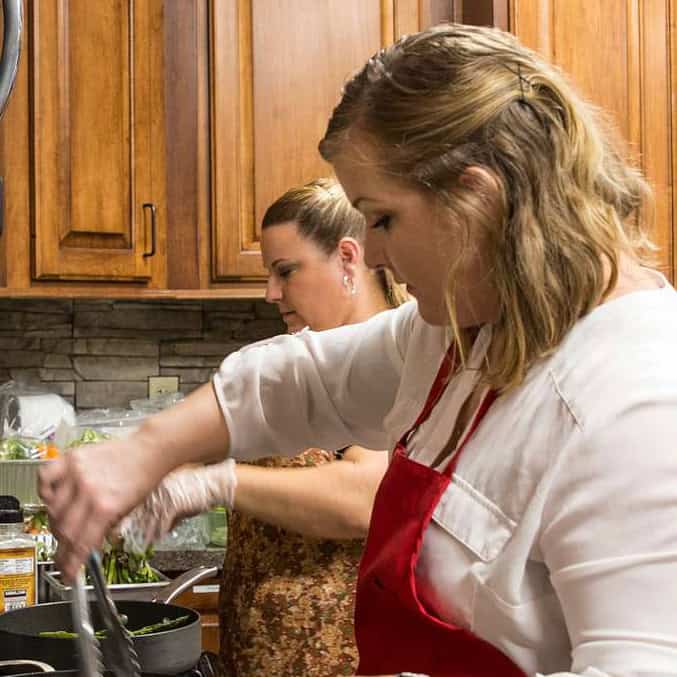
Hello, I am Cristy. I love cooking but what I love most is keeping my kitchen tools and appliances top notch. I enjoy writing about everything I have learned around the kitchen. I believe that keeping your kitchen tools well cleaned and maintained produces the best dishes and drinks. Besides writing and cooking I enjoy traveling, camping, hiking and music.
